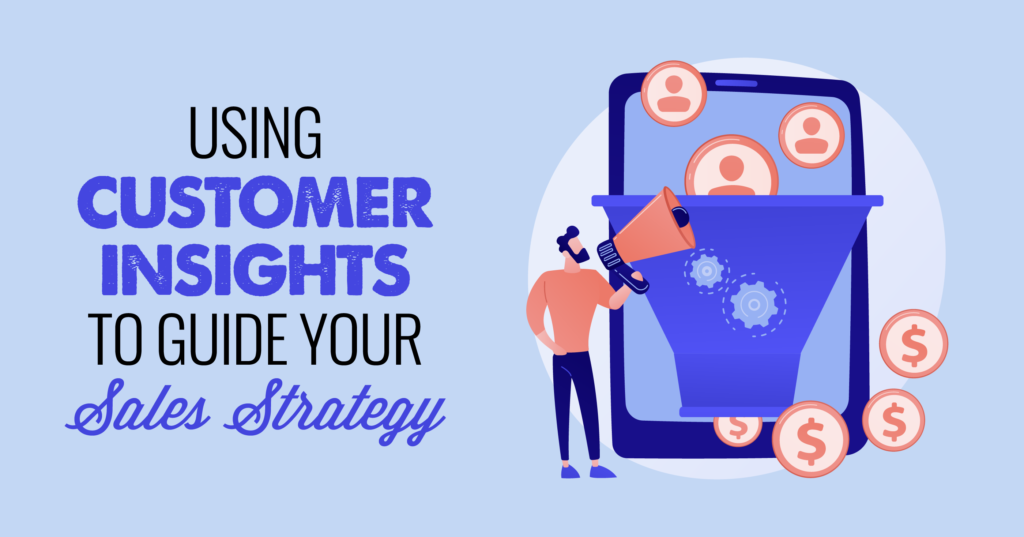

Let’s say you’re offering a new service. You create an engaging, conversion-worthy landing page for your website. Your marketing team advertises your new offering with email newsletters, SMS updates, social media, and PPC ads. Once you’ve put all the right systems in place, it’s up to your salespeople to close the sale.
That’s right: Your salespeople own your relationships with customers. When your salespeople understand your customers, they can tap into prospects’ unique needs to create a personalized, conversion-driving sales presentation. But without the right data, your salespeople risk coming off as untrustworthy and unreliable—and you risk leaving a bad taste in your prospects’ mouths.
[highlight]So, what’s the best way to upgrade your sales strategy? It starts with customer insights. From persona insights to pain points, the right customer insights can help you paint a clear picture of your customers. At the same time, there’s nothing your customers want more than to do business with someone who understands them.[/highlight]
Ready to transform your sales strategy? Here’s how to leverage customer insights to empower your salesforce and keep your appointment book full.
You’ve probably noticed that sales conversations have evolved over the last decade. While in-home salespeople previously offered their expertise, modern customers expect your people to be experts in their needs. The power of personalization is real—and the numbers back it up: 70 percent of customers say that a company’s understanding of their personal needs influences their loyalty.
This dramatic shift has transformed the way salespeople interact with customers. Not only that, but it’s also influenced how contractors approach sales strategy. To turn conversations into conversions, you need to understand your customers—and that starts with tracking customer insights. Here’s how to get started.
Customer insights can be your secret weapon to sales success, but you’ll need to prep your sales team with the right data to boost your conversions. After all, your prospects are constantly growing and evolving—and you need to keep up with a dynamic audience if you want to dominate the competition.
Your salesforce should have access to a wealth of information about your target audience, what they like, and how to connect with them. To start building buyer personas, you’ll need to collect information about:
Once you’ve identified what customer insights will impact your sales strategy, you can start gathering data and sharing it with your sales team. Some key sources of customer insights include:
Now that you’ve gained some key insights into your customers, it’s time to adjust the way your salespeople interact with prospects.
Our clients tell us that refining their strategy to offer a personalized sales experience makes all the difference in their conversion rate. By leveraging insights to create a seamless customer experience, our clients show customers that they genuinely understand their personal needs—all while positioning their business as the perfect solution to solve customer pain points.
Of course, you’ll need to shift your strategy and prep your salesforce with the right insights to drive results. Here’s how to set your sales team up for success.
If you’re not using a customer relationship management (CRM) system, it’s time to start. CRM software supports your team members, helping them manage interactions with leads, prospects, and customers. CRMs store customer information, map out the sales process, analyze key data, and help with other tasks like automation.
When you empower your salespeople with the right data, you create a seamless experience for your customers. By capturing account information through a CRM, people throughout your company—not just a single salesperson—can quickly learn the needs and history of every customer. And when a salesperson leaves the company, you won’t have to worry about leaving their customers behind.
CRM data not only boosts your team’s efficiency, but it can ignite your sales productivity. How? By shedding light on which actions correlate with conversions. With the right insights at your disposal, you can effectively deploy salespeople to engage with qualified leads, close more in-home sales, and improve your bottom line.
It’s not easy to recruit the right salespeople, especially when talent shortages come into play. But even when it feels impossible to source qualified candidates, it’s still crucial to find the right fit for your company culture. At the end of the day, a bad fit can cost you time, money, and countless leads, taking a toll on prospects’ perception of your company.
To boost your sales success, you need team players. When you establish systems and processes that encourage teamwork among your sales team, you’ll create a team-oriented culture that drives success.
What does a team-oriented culture look like? To start, your salesforce shouldn’t shy away from sharing their trade secrets. Instead, your team members should share their best practices for building customer loyalty, creating benefit-focused sales presentations, and closing sales.
If your budget allows, offer short-term incentives to reward long-term sales performance. Track team-based metrics and recognize salespeople not only for meeting quarterly KPIs but for making lasting contributions—whether they’ve found a new way to tap into customer data or closed a major sale.
It’s one thing to say you put customers first, but you can’t make informed decisions about what, when, and how to service them if you don’t know what they want. When you factor customer insights into your sales equation, your salesforce won’t have to rely on gut-feel decisions—and you’ll empower your team with a standout sales strategy that drives results.
Need some help shifting your sales strategy? Whether you’re refining your sales process or searching for the right CRM, we’re here to help. Contact us today to tap into the power of customer insights.